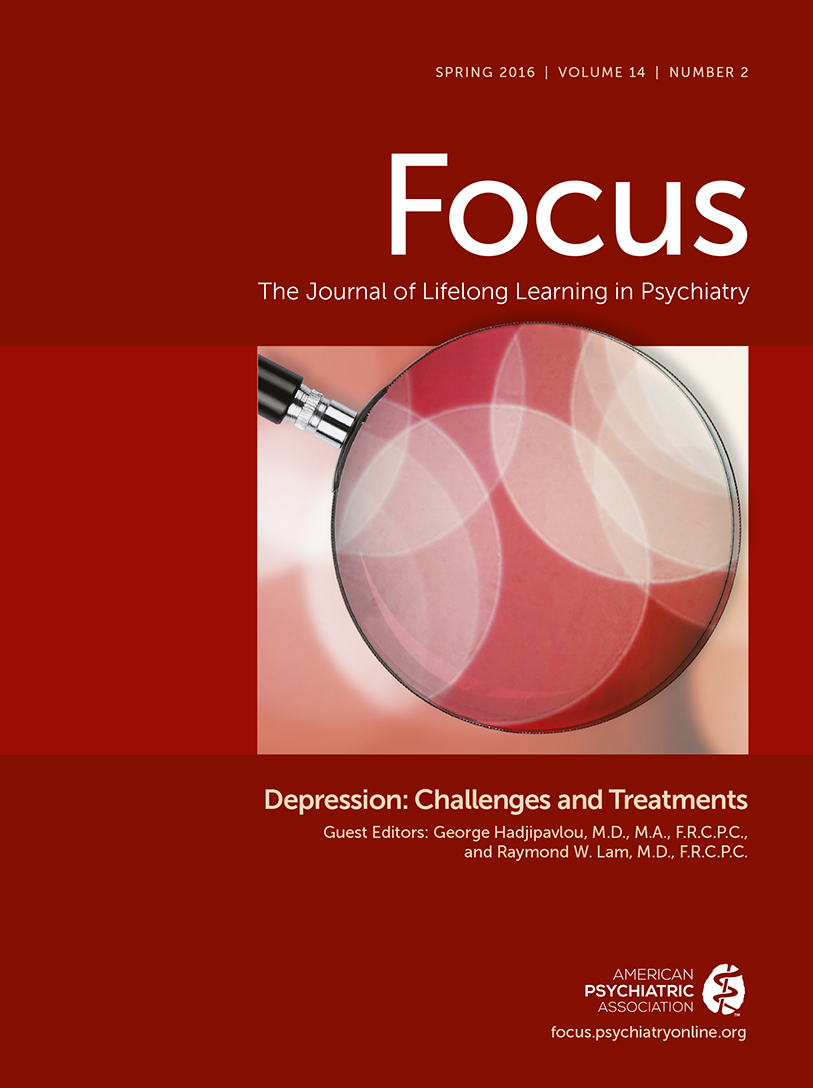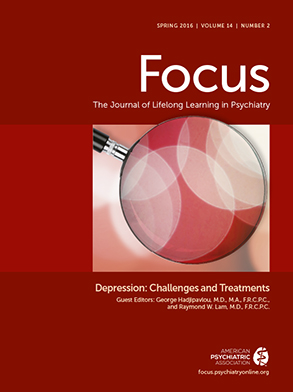Case Vignette
Brenda Madison is a 30-year-old multiracial female who was referred to you by her primary care physician for help with managing a recurrent depression that has been refractory to treatments thus far.
“I’ve been struggling with this depression for months, and nothing seems to be helping this time around,” the patient said when she first met you. Brenda reported two previous lifetime episodes of major depression, both with clear remissions: one at age 20 during her sophomore year in college at a large university (remitted with cognitive-behavioral therapy provided through campus counseling services) and a second at age 26 (remitted with citalopram from her primary care physician). “This time, it began with trouble sleeping, like it always does,” she said, “and then there was the anxiety, the pacing and fidgeting, and the crying.” She further revealed that she was experiencing decreased appetite and enough weight loss that her clothing all “felt baggy.” In your interview, she reported feeling “like I’m a loser, with this damn depression coming back again,” but denied having feelings of guilt. She acknowledged that she could still enjoy getting together with friends for an activity, “but the good feelings fade fast—a few hours later and I’m back down in the dumps.” She noted that she felt fatigued most days, “but with only a few hours of sleep a night, who wouldn’t?” She denied having suicidal thoughts or plans, adding, “I had a friend in college who overdosed on some pills, and she ended up needing a liver transplant. I would never want to inflict that on my family and friends.”
Consideration Point A.
At this point in the assessment of the patient’s history, your differential diagnosis includes current
A.1
______Unipolar major depressive disorder
A.2
______Depression as a part of bipolar disorder
A.3
______Attention-deficit hyperactivity disorder
A.4
______Substance-induced mood disorder
A.5
______Generalized anxiety disorder
Case Vignette Continues
As you asked more questions about Brenda’s current episode, you learned that concentrating at work was difficult for her. She was lead Web designer for a local TV station’s online presence and reported it was challenging to keep the site up to date with the latest news. “It’s pretty noisy in here,” she said, tapping her head, “with worries about ‘am I doing this right?’ ‘did I forget something?’ ‘did I check these details?’ and on and on and on. It’s exhausting! It’s really hard to stay focused on the present.” In response to your question about what things may relieve her symptoms, she volunteered, “When I was in college, I tried to use marijuana and alcohol to calm myself down, but the weed made me too stoned to do well in class, and a couple of hours of being buzzed with alcohol was never worth it. And I didn’t want to go down that road, like my mother’s brother. He was in and out of rehab when I was a kid, and that messed up my cousins.” She confirmed that she would limit herself to one drink when getting together with friends, imbibing maybe twice a month, and she did not smoke marijuana or tobacco at present. She denied using any other substances.
Brenda denied ever having racing thoughts, a reduced need for sleep, periods of excessive goal-directed activity, or engagement in high-risk behaviors. She acknowledged that “sometimes I’m more creative than other times, but it’s just like a day of being ‘in the zone’ when the ideas flow effortlessly, and then on other days it can take forever to come up with something new and different.”
During the current episode, Brenda and her primary care physician had first tried citalopram; the final dose attained was 40 mg/day for eight weeks without any real symptomatic relief or changes on the ECGs done by her primary care physician. They then had tried sertraline and got to 100 mg/day for 12 weeks before Brenda was referred to you. She tolerated both medications adequately, with minimal gastrointestinal upset when first starting out and some reduction in libido.
When you asked about Brenda’s lifetime history, you learned that she was “pretty anxious” in social settings as a child, “but my parents pushed me to join the debate team in junior high and high school, and that helped me learn not to be so anxious when people are watching. ” She denied having gastrointestinal discomfort, sweaty palms, racing pulse, or other panic symptoms when being watched by others. Aside from her anxious worries, she denied experiencing other intrusive thoughts, hallucinations, compulsive rituals, or obsessions. She also denied having problems in childhood with interrupting others, waiting to take turns, climbing on furniture, concentrating at school, acting impulsively, or having difficulty listening to instructions or organizing tasks; if anything, she said, she had been well organized and effective in activities throughout her life, except during the periods of depression.
When recounting her medical history, the patient denied having major medical conditions. During your evaluation, Brenda reported taking sertraline at 100 mg/day and oral contraceptive pills.
Brenda had learned during a prior depressive episode to self-monitor her symptoms with the nine-item Patient Health Questionnaire (PHQ-9) (
1) and brought in a spreadsheet graph showing that her symptoms had not varied much with either prior medication trial, although her score had improved slightly, from 19 prior to starting sertraline to 16. Still, her score was indicative of a moderately severe symptom burden.
Brenda was pleasant and cooperative with the interview, casually attired in a dress with bold colors. Mild psychomotor agitation was noted during the evaluation, as she crossed and uncrossed her legs and fidgeted with her hands. Eye contact was adequate. Speech was of a normal rate, with some monotonous prosody but at normal volume. Affect was fatigued and drained. She characterized her mood as “pretty sad today.” Her thought process was generally linear and coherent. Her thought content was without hallucinations, delusions, or current suicidal or homicidal intent. Cognitively, she was awake; alert; and oriented to self, place, date, and circumstances. Her memory registration was intact with three out of three stimuli, and her recall after delay was three out of three items, although this took some obvious mental effort. She recalled the prior six U.S. presidents without difficulty. Her interpretation of similarities between objects was appropriately abstract (apple/orange = “fruit”; hammer/screwdriver = “tools”). Her insight was good, in that she recognized that she could benefit from effective care. Her judgment was also currently good, in that she was open to considering all options for treatment despite the failure of recent treatment trials to help. Neurologically, her gait, arm swing, turning, stride length, and rapidly alternating movements were all normal. You detected no focal neurological deficits.
Consideration Point B.
Given all of these details, your next therapeutic recommendation or recommendations are
B.1
______Increase the dose of sertraline to 150 or 200 mg/day
B.2
______Switch to another agent, such as vortioxetine
B.3
______Augment her regimen with lithium
B.4
______Start electroconvulsive therapy
Case Vignette Concludes
The patient was most interested in options that involved adding a nonpharmacologic treatment, given her past and current experiences with medication. Brenda had read a lot about rTMS online but believed she would not be able to take time off from work during the day to travel to the nearest center for treatment: “It sounds good, but I just can’t be gone from work that much—I’m already working from early morning ’til nighttime because ‘news happens,’ as we say at the station.” She thought that MBCT resonated better with what she perceived as her issues with “a busy mind, sad thoughts, and worries about the future and past.” You referred her to an MBCT therapist who ran an evening group on Sundays, which fit well with the patient’s weekly schedule. She continued sertraline at 200 mg/day.
The patient reported by phone after two weeks of MBCT that her symptoms had continued to decrease, and at an in-office visit after four weeks of therapy, her PHQ-9 score had declined to 6. After completing the eight-week course of MBCT group therapy, Brenda reported, “I’m myself again,” and she was eager to continue work with you to prevent a recurrence. “I’ve read about recurrence online; I am not thrilled with this, but the odds seem pretty strong that I’ll have another episode at some point, and I’d like to do a lot of living before that happens.” You reinforced the value of her own observation that sleep disturbance had been an early symptom in all three of her episodes and reminded her of her skills with self-monitoring using the PHQ-9. You discussed the value of MBCT practices in preventing relapse and the available data about maintenance medication. You scheduled her for a follow-up visit in three months with the understanding that she could always call for an earlier appointment if her symptoms started to return.


